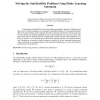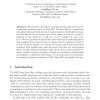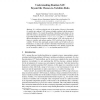22 search results - page 1 / 5 » Incorporating Learning in Grid-Based Randomized SAT Solving |
AIMSA
2008
Springer
13 years 11 months ago
2008
Springer
Abstract. Computational Grids provide a widely distributed computing environment suitable for randomized SAT solving. This paper develops techniques for incorporating learning, kno...
CP
2000
Springer
13 years 8 months ago
2000
Springer
This paper addresses the interaction between randomization, with restart strategies, and learning, an often crucial technique for proving unsatisfiability. We use instances of SAT ...
IJCSA
2007
13 years 4 months ago
2007
A large number of problems that occur in knowledge-representation, learning, VLSI-design, and other areas of artificial intelligence, are essentially satisfiability problems. The ...
SAT
2005
Springer
13 years 10 months ago
2005
Springer
Abstract. We present a new generic problem solving approach for overconstrained problems based on Max-SAT. We first define a clausal form formalism that deals with blocks of clau...
CP
2004
Springer
13 years 10 months ago
2004
Springer
It is well known that the ratio of the number of clauses to the number of variables in a random k-SAT instance is highly correlated with the instance’s empirical hardness. We con...



